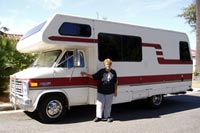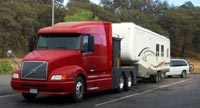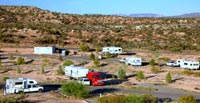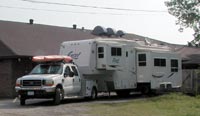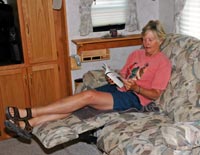| RVing: The Long and Short of It, by Jaimie Hall-Bruzenak |
|
<Previous
Page | Page 1
| 2
|
|
TWO RIGS
Those RVers who have a homebase often have a second rig. My fellow columnist Alice Zyetz lives in a large RV at her home base. "For travel," she says, "I chose a 22-foot Class C so I could park it easily anywhere and wouldn't have to tow a car."
Linda and Earl Hylton had a 33-foot fifth wheel. Then they decided they wanted a shorter rig to fit in Forest Service campgrounds. They bought a 23.5-foot Lazy Daze Class C plus a home base in Quartzsite, Arizona, since they wouldn't enjoy full-time RVing in something that small. Now they are back to a 32-foot fifth wheel. Says Linda, "We know that we won't be able to get into some of the places we like to camp, but this is a temporary situation since, once our name comes up for a lot at an Escapee park in the Northwest, we'll park the fifth wheel at our lot during the summer and get a slide-in truck camper to travel in. We'll then use the fifth wheel to travel in the Southwest during the winter."
Some full-timers want to have the best of both worlds. Guy Gibson, who chose a 35-foot motorhome, says, "I'm thinking of getting a small 4WD camper that is towable, so I can park the "house" and go places that are more peaceful than I usually find."
CHOOSING
Choosing the length of your rig is a matter of priorities. With a really long rig, you are limited in where you can drive and park. Many older campgrounds and public campgrounds cannot accommodate such a large rig or may only have one or two spaces that do. In addition, you may have trouble maneuvering.
On the other hand, going too short means you give up comfort and extras like washer/dryers. In the Lance camper, for example, the only place to sit was the dinette and that was not comfortable for reading, relaxing or using the computer.
Dave and Sandy Baleria (instructors for Life on Wheels) gave their purchase of a full-time rig a lot of though as well as research. "We targeted as our full-timing RV a fifth wheel with four other criteria:
1. Under 30 feet, so we have a lot of freedom to got just about anywhere we want to go
2. Over 3,000 pounds of cargo capacity, due to true full-timing with no land, no lot
3. Not a wide-body, for driving off the freeways with comfort
4. Slideouts only on the left side, not on both sides, as they don't fit well in places such as Elks or Moose lodge parking or older campgrounds."
They bought an 28-foot Excel with two slides with 4,450 pounds of cargo capacity, rated at 4 stars in the RV Consumers Group. Says Dave, "Few other RVs in this size range have as much cargo capacity. But we teach RVing seminars, carry a lot of guide books and electronic and other teaching material." They also carry kayaks and other hobby equipment.
There is no "one size fits all." Says Margaret, "Bigger works for us but may not be the ideal for the next traveler. The length of time you plan to spend on the road as well as the activities you enjoy are determining factors in the length of your RV."
This summer's trip has been a tradeoff
for us too. Sometimes I look down a road or into a campground
where we could have taken the Lance and sigh. But when I lean
back in my recliner to read a good book, I remember why we
are in the New Horizon and I am content.
Jaimie
Hall-Bruzenak
6/3/07
<Previous
page
Page 1|2

